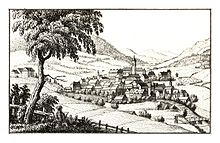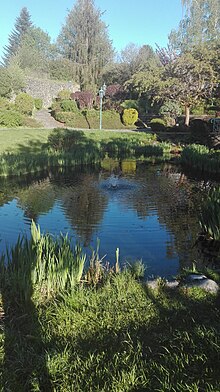City of Rottenmann
|
City of Rottenmann ( City ) Place Cadastral municipality City of Rottenmann |
||
|---|---|---|
|
|
||
| Basic data | ||
| Pole. District , state | Liezen (LI), Styria | |
| Judicial district | Liezen | |
| Pole. local community | Rottenmann | |
| Coordinates | 47 ° 31 '12 " N , 14 ° 21' 0" E | |
| height | 681 m above sea level A. | |
| Residents of the village | 2160 (January 1, 2020) | |
| Area d. KG | 79.99 km² | |
| Post Code | 8786 Rottenmann | |
| prefix | + 43/03614 | |
| Statistical identification | ||
| Locality code | 15859 | |
| Cadastral parish number | 67511 | |
 The city from the castle Strechau from |
||
| Source: STAT : index of places ; BEV : GEONAM ; GIS-Stmk | ||
City of Rottenmann , also just Rottenmann , is the capital of the Austrian town of Rottenmann and has 2160 inhabitants (January 1, 2020). The place is located at an altitude of 681 m above sea level. A. Rottenmann's old town is in the center of the village.
history
10th to 15th centuries
The original Rottenmann was about a kilometer further east in today 's St. Georgen district . Since there was no further expansion of the settlement possible due to the geological conditions (heavy swamp), today's location was planned by a German town planner on the rubble slopes of the local mountain "Stein am Mandl" in the south of the city. In order to protect the merchants who used the heavily frequented salt and trade route - formerly the Roman route - Rottenmann Castle was built at the beginning of the 12th century at the latest and surrounded by walls and moats. From this, today's Rottenmann developed over the years with a wide market street (market place), from which narrow streets branch off at right angles.
The parish church of St. Nicholas is mentioned for the first time around 1266. Until then only as a branch church of Lassing . On October 25, 1279, King Rudolf von Habsburg stayed in Rottenmann for the first time and was likely to have carried out the town elevation during his visit, as Rottenmann was repeatedly referred to as town in various documents in the following years. This makes Rottenmann one of the oldest cities in Austria. The oldest mention of a city judge is recorded in 1296.
After Rottenmann in 1251 of Salzburgian had been occupied troops, this happened again in 1292, when the Styrian nobility covenant - with Salzburg and Bavaria ally - against Duke Albrecht I rebelled. Soon afterwards - in 1320 - the town charter was confirmed for the loyalty to the sovereign, and at the same time Rottenmann was given extremely important and lucrative freedoms of trade, markets and courts; Especially the right to iron and salt deposition and the high income from the nearby silver mines of Oppenberg and Dietmannsberg quickly made the Rottenmann citizens wealthy.
In 1453 the Rottenmann citizen Wolfgang Dietz donated money for the construction of a monastery, after approval by Pope Calixt III. were Augustinian canons from Vienna called to Rottenmann. However, the monastery did not have a really great future, especially during the Reformation it suffered heavily. Emperor Joseph II finally abolished the monastery in 1785. The Rottenmann monastery was later acquired by Eisengewerke Pesendorfer, later by Max Ritter von Gutmann , who sold it to the industrialist Flick when Austria was annexed to the German Empire .
16th to 18th century
The 16th century was marked by the spread of Lutheranism and the resulting disputes and unrest. The barons Hoffmann proved to be decisive promoters of the new faith and soon dominated the entire Paltental and areas beyond. In the course of the subsequent Counter-Reformation, a reform commission was sent to Rottenmann on November 15, 1599 by order of the sovereign - two days later the Evangelical Salvator Church, built only 20 years ago, was reduced to rubble. As a result of the emigration of Lutheran-minded people, Rottenmann only had 116 citizens in 1612, and at that time only those residents were referred to as citizens who could prove that they owned a house within the city walls.
19th century
After the city was occupied twice by French troops, which led to famine and catastrophic conditions, an improvement occurred when Josef Pesendorfer took over iron processing in 1815.
In 1892 the Lapp brothers took over the iron works in Rottenmann and modernized the company. After the Second World War , the plant was continued as Paltenstahlwerk Rottenmann and finally bought by the German industrialist Bauknecht . Today, AHT produces cooling units in Rottenmann .
The district court has existed since 1849, after Rottenmann had its own jurisdiction for centuries.
20th and 21st centuries
Since 2000, the Rottenmann University Center has been a branch of the Graz University of Technology and the Johannes Kepler University in Linz .
Attractions
The old town of Rottenmann is surrounded by a city wall, of which the northern, western and eastern sides are still preserved. On the northern part is the castle gate, an eight meter high tower with a two and a half meter high round gate. Inside the city wall is the castle , which used to house an Augustinian canon monastery (Rottenmann monastery). Today the Caritas Institute for Social Professions is housed there. At the western end of the castle is the parish church of St. Nikolaus with the tallest steeple in Styria for a long time, today it is the second highest. The church is the headquarters of the Parish Association Rottenmann-Oppenberg-Selzthal. The first church was built by the city in the first half of the 13th century, financed by the income from the road toll. At that time still called as a branch church of Lassing. In 1439 the Rottenmann citizen Wolfgang Dietz donated “a lot of money” for a new church building. In 1480, St. Nikolaus became the provost church of the newly founded Augustinian Canons' Monastery. Today's church was built by the church builder Christoff Marl. The oldest frescoes in the parish church date from 1509–1513. All frescoes were whitewashed at the latest during the renovation in 1884 (year on the pulpit), and exposed again during the renovation in 1953. Like many churches in the Enns and Paltental, the Chiemsee Bishop Berthold Pürstinger consecrated four altars in the choir room as suffragan bishop for the Archdiocese of Salzburg. All these altars were replaced by contemporary ones in the baroque period.
West of the church, on the main street, is the Maria am Rain Bürgerspitalkirche, built for the Bürgerspital in the so-called “Salzburger Vorstadt”, founded in 1536 by Johann Christoph von Rappach, and with a neo-Gothic spire at the end of the 19th century.
geography
The old town is embedded in the mountains of the Rottenmanner Tauern . The city is traversed by the Palten, which rises in Wald am Schoberpass .
KG City of Rottenmann
The entire cadastral community of Rottenmann extends over an area of approx. 80 km² and includes 7 other localities: Boder , Bruckmühl , Klamm , St. Georgen , Strechau , Strechen and Villmannsdorf .
Individual evidence
- ^ Franz Brauner, Steirische Heimathefte , Heft 9, Leykam, Graz 1952





